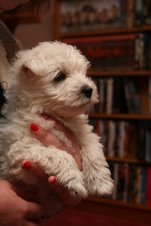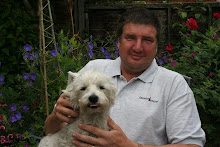 |
| Excellent curds forming. |
With the guests safely returned to their homes we had the house back and quickly moved on to new ways of 'messy-ing' it up. We now have 2 sets of friends who are into the milking of goats and producing more milk than they can handle. Charlotte you will already know about, milking just Nanny Óg and her only on a 50/50 share basis with the kid (Henry Óg, but now shortened to 'Henno'). Well Sue and Rob have recently sold off all their many kids at just 6-8 weeks old, so have inherited, as a result, 3 milking nannies who are going at it like mad things - producing good rich milk and lots of it.
 |
| Scooping out the curds |
As soon as we heard this we put in a bid for "at least 5 litres" (that is a sensible batch size for cheese making) and Sue and Rob duly turned up with 8 creamy litres, fresh and raw. The only cheese making we had done up to that point was the (supermarket) cow's milk Ricotta and then Mozzarella from the kit which I wrote about in a recent post ( http://deefer-dawg.blogspot.ie/2016/03/blessed-are-cheese-makers.html ) and then Liz's small rapid batch the other day. Nothing ventured, though, nothing gained. I chose a recipe from our 'Strawbridge' books for "Feta style" cheese and nabbed the first 5 litres. Liz did an Internet hunt for a soft goat cheese "with rind" with the remaining 3 litres. Both these batches are currently mid process.

We were both amazed by the amount of curd you get from this raw, full cream goat's milk. When the cow's milk curded it separated into the curds, floating on the surface as a 2 inch thick mass with almost clear whey under it. From the 5 litres of cow's milk we actually got back over 4 litres of whey for the pigs (I soak their flaked barley in it, they love it). Because of this, in my ignorance, when I went to cut the curds for this cheese, I only sliced the knife in about 3 inches. When I went to scoop out the curds with the draining spoon, I found that the curds ran right to the bottom - the whole depth of milk had 'set' and the whey was only going to leak out of the cut surfaces of the curd blocks. We both made way more cheese than we had imagined we would.
 |
| The drained mass from the sieve and cheesecloth. |
The curds, once cut, scooped and set to drain, do actually leak that whey slowly so they need to sit in cheesecloth on a sieve or colander and will sag slowly down to about half the volume as the cheese starts to become more dense (and would be pressed for hard cheeses). For my 'Feta' (not actually allowed to call it that as Feta is one of these protected geographic names) the cheese mass now gets spread out on plates and sprinkled with salt to continue the 'cure' while being drained every day.
 |
| Liz filling the moulds. |
Liz's rinded one goes into moulds to drain further and then gets tipped out of the moulds and left to start forming that fungal 'rind' that anyone who likes the French 'chevre' cheeses would be familiar with. That is the stage we are now at for each, the 'Feta' is curing and the rinded one is growing its rind. More on these in future posts. We do not actually possess cheese moulds, of course, so the 'moulds' were a makeshift collection of plastic cups and punnets with lots of holes punched into them using the hot meat-skewer method
 |
| Makeshift moulds. |
All this cheese making put us into 'food processes' mode. We are starting to come into the season for 'harvesting' (nice euphemism) some of the stock so we need freezer space. We generally go through the four freezers doing a bit of an audit deciding what we really need to use up, consolidating the few remaining bits into one or two of the freezers so that we can defrost and clean the empty ones.
 |
| Trying to grow rinds. |
All this efficiency threw up some pig's trotters which I have been meaning to slow-boil into pork jelly for use in some Melton Mowbray style pork pies. It also showed that we have way too many chunks of pork belly left and I could salt some down for streaky bacon rashers (which would admittedly probably end up back in the freezer). Thus spurred on I hauled these goodies out and thawed them for onward processing. The jelly is now made and the pork pies will be made this weekend. The bellies are dry-salted and being drained of brine each day (the salt on the surface draws a huge amount of water out of the meat) for 7 days. There will be room for young Ebony and Ivory, our ram lambs, when they come back from the butcher's on the 4th of July.
 |
I am no expert but i *think* this is a lesser
butterfly orchid found in one of the local
bogs. |
All this food prep has left little time for any other entertainments. I had a nice early start on one of the mornings, woken at some ungodly (but dawn-lit) hour by a loud cacophony of magpie and jackdaw screeches and croaks. A Hell of a din. In my barely awake, befuddled state as I came to hearing this my brain was shouting "Mink in the chicken coop!", "Pine Marten eating the gosling!" and "Fox!", not registering that it was the maggies I was hearing. Leaping out of bed, then, in a hurry, I raced outside in wellies, jocks and my fleecy jacket (I know! Quite a look!) and found Blue the cat had one of our newly-fledged baby magpies on the ground in the cattle race and the rest of the magpie family plus half a dozen jackdaws all "mobbing" him. Soldier, our other cat was moving in too.

Blue was not actually touching the bird but sitting a few inches away, the way cats do, tempting it to try to take off so that he could pounce on it again. The baby just sat there in shock. I reached down and picked up the unprotesting bird and moved it to safety on a compost heap where the cats seemed to lose sight of it and I could hustle them indoors. When I went out later at a more sensible getting up time (07:30), to do the stock, it was gone and later that day I saw the maggies feeding 2 babies which is all we think they have this time, so my youngster may have made it. I am not sure I love magpies - they steal too many chicken eggs - so perhaps I should have dinged this one when I had the chance, but it was too early in the morning and my merciful streak got the better of me. Perhaps they will name the lad 'Lucky'.
 |
| They do, do they? |
Ah well. Enough for this one. More on those cheeses, slabs of bacon and pork pies next time. Cheers.












3 comments:
The white orchid is certainly a butterfly orchid but it could also be the greater butterfly as we have both greater and lesser in Co.Roscommon, the only way to tell is by the pollen sacs, we have them growing nearby but will have to return to the spot to see which one we are looking at.
Thanks for that, Anne, as ever. I too will return to my butterfly orchid with the close-up lenses and get a pic of those pollen sacs. I see from the good book (Fitter, Fitter and Blamey, of course) that it *matters* whether the pollen "masses" are parallel (Lesser) or diverging (Greater). There was actually a 3rd type of orchid down there (by Cloonacolly Lough) with greeny non-descript flower (buds?) but it looked like a not-yet-open butterfly, so perhaps I can picture that too and e-mail you some more detailed shots for ID? If that's not too cheeky?
The butterfly orchid that we found is definitely the lesser, I would love to see the greater for a visual comparison. The green one that you have described might well be Twayblade, see picture on my blog. I invested last year in 'Ireland's Wild Orchids' by Brendan Sayers and Susan Sex, I would describe this book as the definitive field guide to Irish Orchids.
Strange that we ended up taking a photo of the same cottage! We know of another one which also has a large stand of Aconite, it mush have been a very popular plant at one time.
Post a Comment